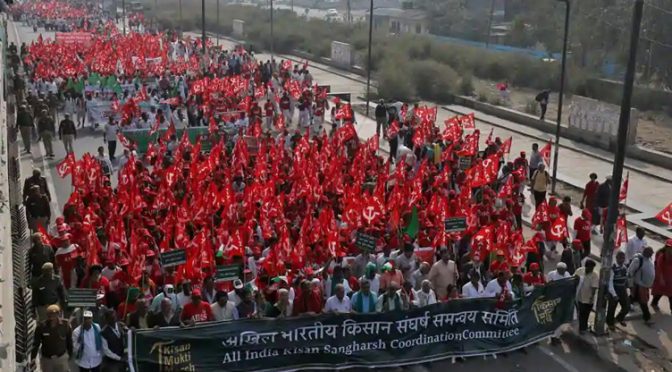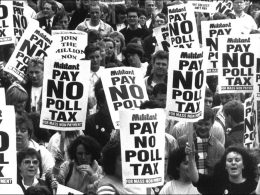Article by members of New Socialist Alternative, our sister organisation in India, about the 150 million strong general strike against the Modi government.
India’s Working Class people have a tremendous history of showing their built-up anger and collective bargaining strength time and again through General Strikes. Since the arrival of the disastrous policies of neo-liberalism in 1991, the working class of India have embarked upon a General Strike 17 times. Last time when we struck work in September 2016, an unprecedented 180 million workers took part in the united class action. Here we are again to strike at the disastrous policies of the BJP – led, National Democratic Alliance (NDA) government, which has failed the working people in all spheres.
It is no exaggeration to say that Modi’s government of the last 4.5 years is the most regressive that India has experienced since independence from the British Raj. It is true that Modi, through his divisive agenda camouflaged as “development”, has held even sections of workers and other oppressed people under an illusionary spell.
But today both Modi and his party – the BJP – stand completely exposed just as the proverbial ‘emperor without clothes’. Increasingly the people are realising that Modi’s pompous programme “Sab ka Sath – Sab ka Vikas” (“With Everyone for Everyone’s Development”) is in fact a confidence trick played on the vast majority, the 99% of commoners, to further enrich the 1% – the rich rupee and dollar billionaires. In effect there has been an unprecedented transfer of wealth from poor to the rich.
The General strike on 8th and 9th January is a class action against the Modi government.
Trade Unions must challenge the system of capitalism!
Dismal Failure in the Jobs front
A staggering 130 lakh (1.3 million) young people are joining the lines of the unemployed every month. Recently in March 2018, as reported by the media, for 90,000 jobs at Indian Railways, 2.8 Crore (28 million) people applied.
According to a recent report by the ILO, in 2018, as many as 18.3 million Indians were unemployed in 2017, and unemployment is projected to increase to 18.9 million by 2019.
More than 200,000 candidates were competing for 1,137 police constable vacancies in Mumbai, many of whom were over-qualified: 423 had degrees in engineering, 167 were Masters in Business Administration and 543 were post-graduates, while the basic qualification required for the post was a simple pass in 12th standard.
As a consequence of Modi’s ‘Demonetisation’ and GST blunders, the economy that was considered to be in the high growth bracket, was knocked down by at least 2% of GDP. The single biggest achievement of Modi’s so-called “development” regime – is that at least 35 lakh jobs have been lost in the Micro, Small and Medium enterprises and retail sectors.
There is widespread resentment among youth with the lack of employment opportunities in the country.
This Strike is a united action demanding meaningful and gainful employment for the youth of this country.
Youth are driven to suicide
India’s establishment political class, from the BJP to Congress, boasts about the demographic dividend. The 2011census data show that around 41 percent of India’s population is below the age of 20, which could serve to its advantage. And yet the statistics on suicides, particularly of young people is staggering, dwarfed only by the phenomenal level of peasant suicides in the country.
India has one of the world’s highest suicide rates for youth aged 15 to 29. In 2016, 9,474 students committed suicide – almost 26 every day. Over 75,000 students have committed suicide in India over the 10 years up to 2016.
In December 2017, an extremely talented, socially conscious and meritorious student – S Anita from Tamil Nadu took her own life after getting denied a seat to qualify herself as a Doctor of Medicine. In spite of securing 1,176 marks out 1200 in 12th standard examinations, she failed in the NEET (National Eligibility and Entrance Test).
Anita’s death by suicide exposed the rottenness of the Indian education, which has entrenched caste bias and is grotesquely driven by the urban-rural divide. The NEET and other entrance examinations are increasingly seen as a clever ploy to deny the rural youth from economically and socially oppressed backgrounds entry into medical and technical professions.
Similarly to the death of student/scholar Rohit Vemula, in the year of 2016, Anita’s death was caused by the brutality of the deeply entrenched Caste System and exposed the failure of India’s capitalist class in truly developing the society. Irrespective of which set of bandits are in power, the system has utterly failed.
The 2011 census revealed that only 4.5 percent of the population in the country is educated up to the level of graduate or above, while 32.6 per cent of the population is not even educated up to the primary school level. There is no need to elaborate, which classes and castes the highest numbers of hopelessly educated youth come from.
The two day General Strike is against the appalling education system which only serves the privileged rich. We demand universal free education for all, without any hidden or explicit discrimination on the basis of caste, religion or gender.
Modi’s BJP regime is communal to the core
As many as 2,920 “communal incidents” were reported in India over the four years ending in 2017, in which 389 people were killed and 8,890 injured, according to replies from the Ministry of Home Affairs’ to questions in the Lok Sabha (lower house of parliament).
Uttar Pradesh (UP) – India’s most populous state – reported the most incidents (645) over the last four years, followed by the ninth-most populous, Karnataka (379) and the second-most populous, Maharashtra (316). UP also reported the most deaths in these communal incidents (121) between
2014 and 2017, followed by Rajasthan (36) and Karnataka (35).
But here Modi and his accomplices, who are backed to the hilt by a well-oiled ‘Hate Industrial Complex’; the Sangh Parivar, have systematically endangered the edifice of constitutional democracy. They have not only let loose their goons to lynch, kill and terrorise Muslims, Dalits and other oppressed minorities, but even create an aura of great achievements and in that way polarise society on communal and sectarian lines.
Systemic inequality – the ticking time bomb
The number of dollar millionaires in India in 2014 rose to 2.5 lakh from 1.96 lakh in 2013 – an increase of 27 per cent, according to a recent report. The report also predicted that India will have 4.37 lakh millionaires by 2018, and potentially double that number by 2023. This growth is primarily driven by the increase in wealth of a few individuals rather than an overall increase in income levels of all Indian people.
While the number of millionaires increased steadily, the rural India, which constitutes 66% of the total population, still languished in poverty. The highest paid member of three quarters of rural households in India earned less than ₹5,000 (around $72) per month.
We stand in total solidarity with the rural peasantry which is demanding the total write-off of farm loans, minimum support price for agricultural produce and cheap and affordable credit.
On 31st August 2016, just prior to the historic general strike of that year, Finance Minister Jaitley tried to scuttle the determination of the workers by unilaterally announcing ₹ 15,000 as the national minimum wage. But no concrete step has been taken to implement even that abysmal amount.
Trade unions, in line with the recommendations of the Seventh Pay Commission, are now demanding a minimum monthly wage of ₹18,000 per month or ₹ 692 a day and a base pension of ₹3,000 a month. While in comparison to the present starvation wages prevalent in the country, this may look like a reasonable increase (if it comes about), the ground reality is very different. People are reeling under the high prices of all essentials and the astronomical rents in urban India. Hence the grass-roots campaigns like ‘Fight for ₹100/- an hr. Living Minimum Wage’ urge the trade unions to put forward the fighting demand of a monthly minimum of ₹ 25,000 and at least half of that amount as a basic pension for all.
We are striking against the ruling capitalist class and its representatives – be it from the BJP or Congress – and demanding a living minimum wage of ₹25,000 for all workers.
It is no wonder that even the bosses’ press in India have taken notice of the coming general strike of the 8th and 9th of January. They are predicting the numbers to even surpass the 180 million of the last one. Recently, more than 300,000, farmers marched against Modi’s failure to provide much-needed financial compensation to the peasantry. They have lost more than 3 lakh of their brothers and sisters who have committed suicide in the span 20 years since the neo-liberalism-induced impoverishment and farm debt burden.
There is increasing solidarity of purpose between the rural peasantry and the urban working class. On 29th of November, workers and students marched behind the peasantry in the streets of Delhi, showing their solidarity. In the aftermath of the peasants’ mobilisation and the unprecedented phenomenon of a joint demonstration, triggered by the disastrous policies of Modi’s regime that affect all sections of the population, this general strike is bound to be historic.
In all likelihood, the numbers in this strike will be record-breaking. But the question is: towards what political end will it lead? We, the working class and the other oppressed sections of our society cannot be treated yet again as cannon fodder to bargain for a few crumbs from the rival gangs of the capitalist class in this country.
Political alternative
This strike is happening when the 2019 general election is just four months away, is increasingly raising hopes that the much-hated regime of Modi may come to an end. But the crucial question is: To be replaced with what?
The leadership of the left, particularly of the Communist Parties, are yet again proposing and advocating the disastrous policy of the “lesser evil” and promoting the line of the Congress-led coalition as an alternative to the right-wing, authoritarian and communal Modi regime. If that happens, it will be a repetition of history, this time as farce.
The recent results of the five state assembly elections show that in Rajasthan, Madhya Pradesh and Chattisgarh, which is considered predominantly Hindu, here Modi’s communal politics were rejected. By default, Congress ascended the seat of power in these states. But it has to be emphasised that the kind of slender margins that the Congress has got in these states goes to show that both the BJP and Congress are rejected.
The choice of Kamal Nath as Chief Minister of Madhya Pradesh, has raised many eyebrows even among the left, as he is one of those perpetrators of the bloody violence of the 1984 anti-Sikh riots. The reactionary conduct of the Congress Party in Sabarimala, exposes the thin veneer of so-called “secular” credentials that Communists want to tag them with, in order to justify their alliance with them. Sections of progressive women there are conducting a mass struggle, supported by millions within and beyond the state, for gender justice and to be treated as equals. They are having to demand the implementation of the Supreme Court verdict in relation to the right of all women to enter temples, irrespective of their age.
Even if Modi is dislodged from power in the general elections, the RSS and its Parivar have in place all the monstrous paraphernalia to bounce back with a vengeance. History records that in both victory and defeat they have grown stronger. One of the reasons is that a very fertile ground is provided by the caste system. The myth of the all-encompassing “Hindu Samaj” (Hindu Society) is a clever and dubious concept coming out of the RSS think tank to maintain the vice-like grip of the oppressor castes. Ironically, the capitalist economy and the system that it administers should have fought against these medieval vestiges, but instead they have nurtured them and provide a pedestal for them to flourish in their own narrow self-interest. Hence, the fight here is long-drawn out and even could be bloodier.
A left alternative – a socialist alternative – is the crying need of the hour, but the predominantly Communist-led Trade Unions have missed several historic opportunities. The most recent was in 2016 when Modi gave them a golden opportunity, through the Demonetisation blunder, when for at least 10 weeks the entire population was seething with anger against the regime of the BJP.
Although now the objective situation has moved on, the recent mobilisations of peasants, students, traders, LGBTQi and Dalits provides an opportunity to build a genuine alternative to the current capitalist regime, steeped as it is in communalism and Casteism. No longer can we be fooled with the politics of ‘Tweedledee and Tweedledum’ choices.
Let’s make use of this Class Action of General Strike to discuss and build an Independent Working Class- led Socialist Alternative, allying with all the oppressed sections of society.
Capitalism has failed us, let’s change it.
It is proven beyond any doubt that the capitalism has miserably failed in solving the fundamental problems of poverty, illiteracy squalor, disease, unemployment, landlessness & housing. It continues the discrimination by caste, class, gender, sexuality and national identity. In fact its greed for profits is threatening the very ecological balance of earth. Environmental concerns can not be left to these “specialists” whose priorities are wealth over welfare, profit over people, greed over green.
Capitalism shows no way out; a fighting, militant, combative approach is necessary in day-to-day struggles of the working class which should collaborate with the struggles of the women, urban & rural poor and of the indigenous Adivasi and Daliths, for a stronger alliance linked to the idea of the socialist transformation of society.
The working class and its organisations should fight for:
A Living Minimum Wage of Rs. 25,000 to all
An immediate stop to the Bosses HIRE & FIRE policy.
Right to Employment for all.
We demand universal free education for all.
Universal Health care for all. Nationalise all private hospitals.
Abolition of Contract & Casual Labour Permanent and Secure employment for all.
Roll back all regressive labour “reforms” immediately.
Re-nationalise all Industries and Public utilities.
No merger of any Nationalised Banks – Bring NPA defaulters to books.
Tax the rich through increased direct taxes. Abolish indirect taxes which burden the poor.
Take up land distribution now! Break up the Capitalist-Landlord nexus.
We demand immediate redressal of grievances farmers and peasants with MSP, cheap credit through nationalise banks and total write-off of debts.
Trade Union & Political rights to all the workers in Public and Private Sectors.












